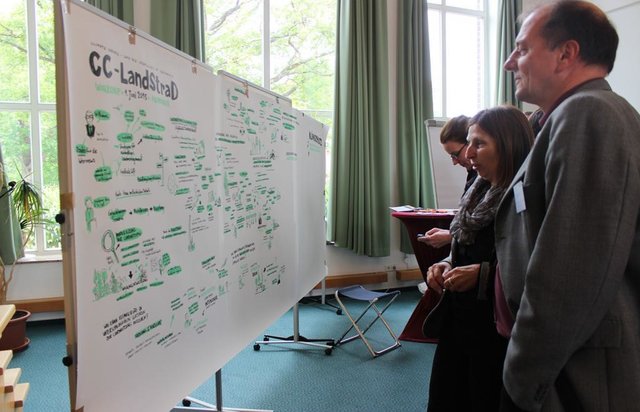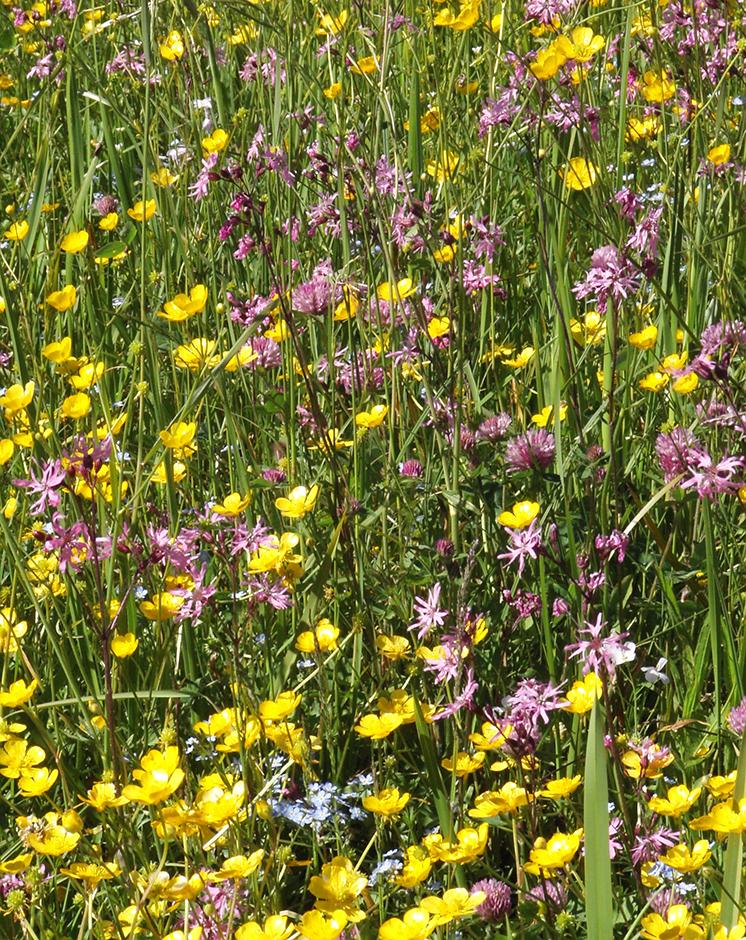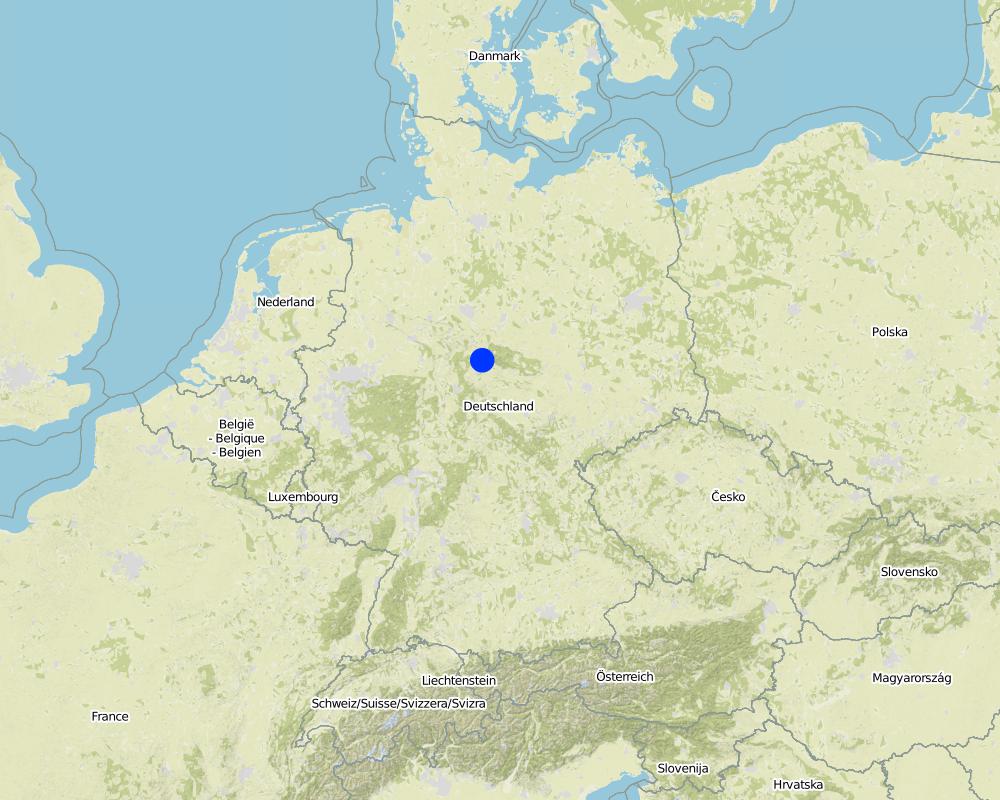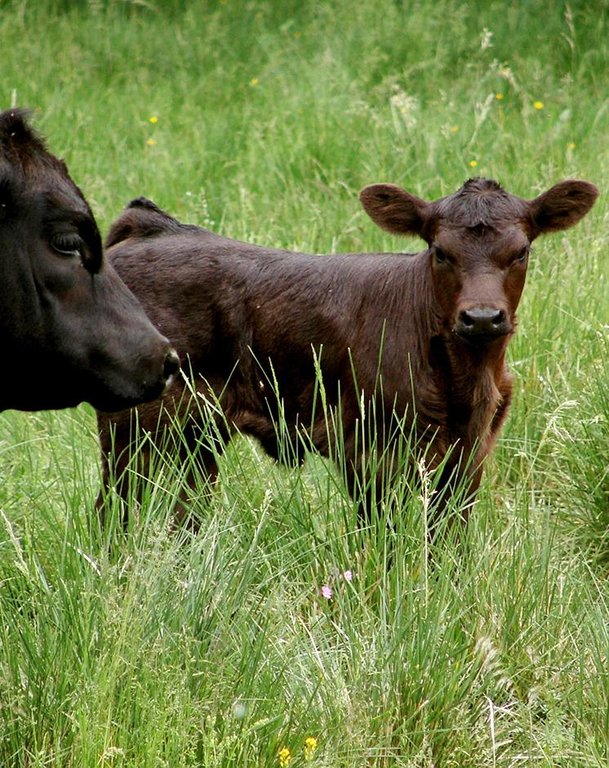Grassland preservation [Germany]
- Creation:
- Update:
- Compiler: Johanna Fick
- Editor: –
- Reviewers: Fabian Ottiger, Deborah Niggli, Alexandra Gavilano
technologies_1699 - Germany
View sections
Expand all Collapse all1. General information
1.2 Contact details of resource persons and institutions involved in the assessment and documentation of the Technology
SLM specialist:
Baum Sarah
Thünen Institute of Rural Studies
Germany
Name of project which facilitated the documentation/ evaluation of the Technology (if relevant)
Book project: Making sense of research for sustainable land management (GLUES)Name of project which facilitated the documentation/ evaluation of the Technology (if relevant)
Climate Change - Land Use Strategies (CC-LandStraD / GLUES)Name of the institution(s) which facilitated the documentation/ evaluation of the Technology (if relevant)
Thünen Institute (Thünen Institute) - Germany1.3 Conditions regarding the use of data documented through WOCAT
The compiler and key resource person(s) accept the conditions regarding the use of data documented through WOCAT:
Ja
1.4 Declaration on sustainability of the described Technology
Is the Technology described here problematic with regard to land degradation, so that it cannot be declared a sustainable land management technology?
Nee
1.5 Reference to Questionnaire(s) on SLM Approaches (documented using WOCAT)

Open dialogue platform on sustainable land management [Germany]
Establishing a dialogue platform on sustainable land management which is open to all stakeholders
- Compiler: Johanna Fick
2. Description of the SLM Technology
2.1 Short description of the Technology
Definition of the Technology:
Grassland preservation by the avoidance of ploughing up of grassland and its transformation into cropland
2.2 Detailed description of the Technology
Description:
Increasing demand for food, feed and bioenergy provokes an increased demand for cropland. This leads to intensification of grassland and conversion of e.g. grassland to cropland. By converting grassland to cropland the enhanced mineralization of organic soil matter leads to high emissions of the greenhouse gases CO2 and, in a much lower extent, N2O. the other way around, if cropland is converted to grassland a long-term carbon sink is established that accumulates high amounts of carbon. Nevertheless the conversion of cropland to grassland cannot compensate GHG emissions caused by conversion of grassland to cropland. Due to the soil structure and characteristics C-sequestration in the soil is higher for grassland than for cropland and within the grasslands it is substantially higher for old, humus-rich and boggy sites (e.g. fens or peatbogs) than for young grassland on mineral soils (Schuler et al. 2014). GHG emissions from converting grassland to cropland are more than 12.5 times per areaunit higher for organic than for mineral soils (own calculations after UBA 2014). Avoiding conversion of grassland into cropland avoids on average 10 tCO2-equ/ha*a considering a time-period of ten years (Osterburg et al. 2009).
Purpose of the Technology: The aim of grassland preservation is to avoid/reduce GHG emissions and maintain and develop a carbon sink. Furthermore, grassland habitats have higher biodiversity than croplands and are, in general, less intensively managed. Thus, inputs of fertilizers and pesticides are lower, which is beneficial for water quality regardless of how intensively the grassland is managed. Unlike cropland, grassland is not ploughed or harrowed annually, resulting in better soil protection and a lower risk of erosion; the latter because of the year-round vegetation cover.
Establishment / maintenance activities and inputs: During a research project, the interdependencies between climate change and land use were analysed, and different strategies for sustainable land use management in Germany were modelled. Relevant land use measures which can contribute to the reduction of GHG emissions were evaluated with respect to climate mitigation, bioenergy by biomass, environmental and biodiversity protection (www.cc-landstrad.de). Grassland preservation is one land use practice which showed multiple advantages compared to cropland (after conversion from pasture): these were higher carbon sequestration and lower GHG emissions, better soil protection against erosion, and improved water storage capacity. The disadvantages and thus trade-off of grassland preservation are foregoing production of high-yielding cash crops, higher labour demand per hectare, and lower agricultural income. However, given the importance of preserving carbon stocks accumulated under grassland, the existing pastures should be retained wherever possible. The preservation of grassland is recommended everywhere, but especially for areas with organic soils/peaty soils - as high GHG emissions are the consequence otherwise.
2.3 Photos of the Technology
2.5 Country/ region/ locations where the Technology has been applied and which are covered by this assessment
Country:
Germany
Region/ State/ Province:
Germany
Further specification of location:
Nationwide
Comments:
Total area covered by the SLM Technology is 375000 m2.
Technology is modelled for all agricultural sites in Germany and was not implemented in a precise case.
Boundary points of the Technology area: 54.880451; 8.944112
50.955417; 14.836034
47.483324; 13.013274
47.590007; 7.595230
50.956057; 5.884301
53.567827; 6.999686
Technology is modelled for all agricultural sites in Germany and was not implemented in a precise case.
Map
×2.6 Date of implementation
If precise year is not known, indicate approximate date:
- 10-50 years ago
2.7 Introduction of the Technology
Specify how the Technology was introduced:
- through projects/ external interventions
Comments (type of project, etc.):
Introduction of Cross Compliance (requirement for direct payment) in 2005 in the EU for protection and preservation of grassland
Technology has been refined and increased its significance especially in the past 10 years.
3. Classification of the SLM Technology
3.1 Main purpose(s) of the Technology
- improve production
- reduce, prevent, restore land degradation
3.2 Current land use type(s) where the Technology is applied

Grazing land
Extensive grazing:
- Ranching
Intensive grazing/ fodder production:
- Cut-and-carry/ zero grazing
- Improved pastures
Animal type:
- horses
- sheep
- cattle
Comments:
Major land use problems (compiler’s opinion): Increasing demand for cropland area, and higher income options by cultivating cropland rather than grassland, thus loss of GHGs through conversion.
Major land use problems (land users’ perception): Increasing demand for cropland area. Grassland conversion into cropland might increase the farmer’s income if the soil is suitable for cropping.
Ranching: Cattle, sheep, horses
Cut-and-carry/ zero grazing: Yes
Improved pasture: Yes
Number of growing seasons per year: 1
Longest growing period in days: 235
Livestock density: 50-100 LU /km2
3.5 SLM group to which the Technology belongs
- minimal soil disturbance
- Carbon sink
3.6 SLM measures comprising the Technology

management measures
- M2: Change of management/ intensity level
3.7 Main types of land degradation addressed by the Technology

soil erosion by water
- Wt: loss of topsoil/ surface erosion

soil erosion by wind
- Et: loss of topsoil

biological degradation
- Bc: reduction of vegetation cover
- Bh: loss of habitats
- Bs: quality and species composition/ diversity decline
- Bl: loss of soil life

water degradation
- Ha: aridification
- Hp: decline of surface water quality
- Hq: decline of groundwater quality
- Hw: reduction of the buffering capacity of wetland areas
Comments:
Main causes of degradation: soil management (land use change connected with ploughing), crop management (annual, perennial, tree/shrub) (annual), increasing demand for land
3.8 Prevention, reduction, or restoration of land degradation
Specify the goal of the Technology with regard to land degradation:
- prevent land degradation
- reduce land degradation
4. Technical specifications, implementation activities, inputs, and costs
4.1 Technical drawing of the Technology
Technical specifications (related to technical drawing):
Extensive suckler cow husbandry
Location: Arnegger Ried. Ulm, Baden-Wurttemberg, Germany
Date: 30.05.2013
Technical knowledge required for field staff / advisors: low
Technical knowledge required for land users: low
Main technical functions: improvement of ground cover, stabilisation of soil (eg by tree roots against land slides), increase in organic matter
Secondary technical functions: improvement of water quality, buffering / filtering water, reduction in wind speed, promotion of vegetation species and varieties (quality, eg palatable fodder)
Author:
Norbert Röder, Bundesallee 50, 38116 Braunschweig, Germany
4.5 Maintenance/ recurrent activities
| Activity | Timing/ frequency | |
|---|---|---|
| 1. | The costs depend on the intensity of the management, the more intensive the use the higher the cost (e.g. reseeding etc.) |
4.6 Costs and inputs needed for maintenance/ recurrent activities (per year)
| Specify input | Unit | Quantity | Costs per Unit | Total costs per input | % of costs borne by land users | |
|---|---|---|---|---|---|---|
| Labour | Labour | ha | 1.0 | 135.0 | 135.0 | 100.0 |
| Equipment | Machine use | ha | 1.0 | 100.0 | 100.0 | 100.0 |
| Plant material | Seeds | ha | 1.0 | 100.0 | 100.0 | 100.0 |
| Total costs for maintenance of the Technology | 335.0 | |||||
| Total costs for maintenance of the Technology in USD | 335.0 | |||||
4.7 Most important factors affecting the costs
Describe the most determinate factors affecting the costs:
There are no direct costs if grassland is not converted but managed as before but there might be opportunity costs: If a farmer would convert his grassland to cropland and cultivate arable crops he might have a higher profit than he would have from grassland cultivation.
5. Natural and human environment
5.1 Climate
Annual rainfall
- < 250 mm
- 251-500 mm
- 501-750 mm
- 751-1,000 mm
- 1,001-1,500 mm
- 1,501-2,000 mm
- 2,001-3,000 mm
- 3,001-4,000 mm
- > 4,000 mm
Specifications/ comments on rainfall:
Annual rainfall: 250-500 mm, 500-750 mm, 750-1000 mm, 1000-1500 mm (Annual precipitation for Germany ranges between circa 430-1275mm)
Agro-climatic zone
- humid
Thermal climate class: temperate
5.2 Topography
Slopes on average:
- flat (0-2%)
- gentle (3-5%)
- moderate (6-10%)
- rolling (11-15%)
- hilly (16-30%)
- steep (31-60%)
- very steep (>60%)
Landforms:
- plateau/plains
- ridges
- mountain slopes
- hill slopes
- footslopes
- valley floors
Altitudinal zone:
- 0-100 m a.s.l.
- 101-500 m a.s.l.
- 501-1,000 m a.s.l.
- 1,001-1,500 m a.s.l.
- 1,501-2,000 m a.s.l.
- 2,001-2,500 m a.s.l.
- 2,501-3,000 m a.s.l.
- 3,001-4,000 m a.s.l.
- > 4,000 m a.s.l.
5.3 Soils
Soil depth on average:
- very shallow (0-20 cm)
- shallow (21-50 cm)
- moderately deep (51-80 cm)
- deep (81-120 cm)
- very deep (> 120 cm)
If available, attach full soil description or specify the available information, e.g. soil type, soil PH/ acidity, Cation Exchange Capacity, nitrogen, salinity etc.
Soil depth on average: Very shallow-shallow (Aspects not relevant. Further, grasslands are distributed german-wide and thus conditions are diverse)
Soil texture (Aspects not relevant. Further, grasslands are distributed german-wide and thus conditions are diverse).
Soil fertility (Aspects not relevant. Further, grasslands are distributed german-wide and thus conditions are diverse).
Topsoil organic matter (Aspects not relevant. Further, grasslands are distributed german-wide and thus conditions are diverse).
Soil drainage/infiltration is good
Soil water storage capacity is very high
5.4 Water availability and quality
Ground water table:
< 5 m
Availability of surface water:
good
Water quality (untreated):
for agricultural use only (irrigation)
5.5 Biodiversity
Species diversity:
- high
Comments and further specifications on biodiversity:
Especially extensive grassland is species rich and contains rare and specialized species
5.6 Characteristics of land users applying the Technology
Market orientation of production system:
- commercial/ market
Individuals or groups:
- individual/ household
Gender:
- women
- men
Indicate other relevant characteristics of the land users:
Land users applying the Technology are mainly common / average land users
Population density: 200-500 persons/km2
Annual population growth: < 0.5%
Market orientation of production system: nature conservation
5.7 Average area of land used by land users applying the Technology
- < 0.5 ha
- 0.5-1 ha
- 1-2 ha
- 2-5 ha
- 5-15 ha
- 15-50 ha
- 50-100 ha
- 100-500 ha
- 500-1,000 ha
- 1,000-10,000 ha
- > 10,000 ha
Comments:
Average area of land owned or leased by land users applying the Technology: 5-15 ha, 5-15 ha, 15-50 ha
Size of cropland per household:
Grassland 4.700.000 ha, houshould 40.200.000
Size of grazing land per household: farms 300.000 grassland 4.700.000 ha
5.8 Land ownership, land use rights, and water use rights
Land ownership:
- individual, not titled
- NGO
Land use rights:
- individual
Comments:
human environment: Grassland per household: Grassland 4.700.000 ha, farms 300.000
6. Impacts and concluding statements
6.1 On-site impacts the Technology has shown
Socio-economic impacts
Production
crop production
product diversity
Water availability and quality
drinking water availability
Comments/ specify:
In areas with low precipitation
drinking water quality
Comments/ specify:
In areas with low precipitation
demand for irrigation water
Comments/ specify:
perhaps
Income and costs
expenses on agricultural inputs
Comments/ specify:
Yes
farm income
workload
Socio-cultural impacts
recreational opportunities
Improved livelihoods and human well-being
Comments/ specify:
Disadvantages will realised if grassland preservation won't be done.
Ecological impacts
Water cycle/ runoff
water quality
Comments/ specify:
Yes: Due to fertilization, pesticides
surface runoff
Soil
soil moisture
soil cover
soil loss
soil crusting/ sealing
soil compaction
nutrient cycling/ recharge
soil organic matter/ below ground C
Biodiversity: vegetation, animals
plant diversity
beneficial species
habitat diversity
Climate and disaster risk reduction
emission of carbon and greenhouse gases
Other ecological impacts
Hazard towards adverse events
6.2 Off-site impacts the Technology has shown
wind transported sediments
6.3 Exposure and sensitivity of the Technology to gradual climate change and climate-related extremes/ disasters (as perceived by land users)
Gradual climate change
Gradual climate change
| Season | increase or decrease | How does the Technology cope with it? | |
|---|---|---|---|
| annual temperature | increase | well |
Climate-related extremes (disasters)
Meteorological disasters
| How does the Technology cope with it? | |
|---|---|
| local rainstorm | well |
| local windstorm | well |
Climatological disasters
| How does the Technology cope with it? | |
|---|---|
| drought | well |
Hydrological disasters
| How does the Technology cope with it? | |
|---|---|
| general (river) flood | well |
Other climate-related consequences
Other climate-related consequences
| How does the Technology cope with it? | |
|---|---|
| reduced growing period | well |
6.4 Cost-benefit analysis
How do the benefits compare with the establishment costs (from land users’ perspective)?
Short-term returns:
negative
Long-term returns:
negative
How do the benefits compare with the maintenance/ recurrent costs (from land users' perspective)?
Short-term returns:
negative
Long-term returns:
very negative
Comments:
main cost are opportunity cost of arable land use, they occur yearly.
6.5 Adoption of the Technology
Comments:
There is a strong trend towards spontaneous adoption of the Technology
Comments on adoption trend: Within the Common Agricultural Policy of the EU reform grassland protection is enhanced since 1 January 2015. In Germany the conversion of grassland is subject to approval and in general only permitted if the same area converted is established as grassland in the same region.
6.7 Strengths/ advantages/ opportunities of the Technology
| Strengths/ advantages/ opportunities in the land user’s view |
|---|
| Conservation/restoration of regional typically landscapes. |
| Strengths/ advantages/ opportunities in the compiler’s or other key resource person’s view |
|---|
| By avoiding conversion of grassland to cropland huge amounts of GHG emissions can be avoided. Further advantages are a lower risk of soil erosion, possible flood prevention, lower levels of fertilizers and pesticides leaching into runoff waters, and higher biodiversity conservation. |
6.8 Weaknesses/ disadvantages/ risks of the Technology and ways of overcoming them
| Weaknesses/ disadvantages/ risks in the land user’s view | How can they be overcome? |
|---|---|
| The income from grassland might – if location factors like soil, water availability are suitable – be lower than it would be for cropland. Thus, there can be high opportunity costs of preserving grassland. | Grassland preservation can be enhanced by legal restrictions. Financial incentives for land users make grassland preservation more attractive from an economical point of view. |
7. References and links
7.1 Methods/ sources of information
- field visits, field surveys
- interviews with land users
When were the data compiled (in the field)?
29/07/2015
7.2 References to available publications
Title, author, year, ISBN:
UBA (2014)
Available from where? Costs?
http://www.umweltbundesamt.de/publikationen/schwerpunkte-2014
Title, author, year, ISBN:
Osterburg B et al. (2009) Erfassung, Bewertung und Minderung von Treibhausgasemissionen des deutschen Agrar- und Ernährungssektors.
Available from where? Costs?
Studie im Auftrag des Bundesministeriums für Ernährung, Landwirtschaft und Verbraucherschutz. Arbeitsberichte aus der vTI-Agrarökonomie 2009/03, Braunschweig, Hamburg, Trenthorst
Title, author, year, ISBN:
Schuler J et al. (2014) Instrumente zur Stärkung von Synergien zwischen Natur- und Klimaschutz im Bereich Landbewirtschaftung
Available from where? Costs?
BfN-Skripten, pp. 187. Bonn, Bad Godesberg
Available from where? Costs?
http://www.umweltbundesamt.de/publikationen/berichterstattung-unter-der-klimarahmenkonvention
Available from where? Costs?
http://www.umweltbundesamt.de/publikationen/berichterstattung-unter-der-klimarahmenkonvention
7.3 Links to relevant online information
URL:
http://www.umweltbundesamt.de/publikationen/submission-under-the-united-nations-framework
Links and modules
Expand all Collapse allLinks

Open dialogue platform on sustainable land management [Germany]
Establishing a dialogue platform on sustainable land management which is open to all stakeholders
- Compiler: Johanna Fick
Modules
No modules





